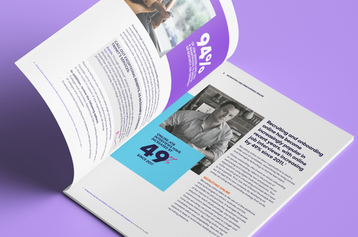
Table of contents
- 1.Set Clear Expectations and Goals
- 2.Foster a Positive Work Environment
- 3.Offer Professional Development and Training
- 4.Recognize and Reward Performance
- 5.Implement Effective Time Management Techniques
- 6.Provide the Right Tools and Resources
- 7.Promote Work-Life Balance
- 8.Create a Culture of Accountability
- 9.Encourage Team Collaboration and Communication
- 10.Set Up Continuous Feedback Loops
- 11.Conclusion
Want to get the most out of your team? Improving employee productivity and performance is one of the best ways to drive results and keep your business moving forward. When employees are motivated and efficient, everyone wins—from the team to the bottom line. Whether you're a manager, business owner, or team leader, it’s clear that enhancing performance is key to hitting your company’s goals. Creating an environment where employees feel supported, equipped, and motivated is key to unlocking their full potential. In this article, we’ll dive into some practical ways to boost employee productivity and performance.
1. Set Clear Expectations and Goals
Setting clear goals is a game-changer for productivity. When employees know exactly what's expected of them, it’s easier for them to stay focused and work efficiently. Having clear goals also helps employees understand what success looks like and gives them something to aim for. One approach that works well is setting SMART goals (Specific, Measurable, Achievable, Relevant, Time-bound), which makes everything more tangible. For example, instead of setting a vague goal like "improve sales," a SMART goal would be "increase sales by 10% over the next quarter."
Clear goals not only make it easier to track progress but also ensure that everyone is on the same page. This clarity helps drive performance by keeping employees focused on what’s important. A well-defined goal can also act as a benchmark to measure success, making employees feel a sense of accomplishment when they meet or exceed it. Moreover, clear expectations can prevent misunderstandings, reduce frustration, and ensure that team members align with the company’s larger objectives.
You can also break down bigger company-wide goals into smaller, individual milestones for each team member. This makes the larger goal feel more achievable and gives employees a sense of ownership over their specific contributions. For instance, if your company is looking to increase customer satisfaction, individual goals for your customer service team could be based on reducing response times or improving customer feedback scores.
2. Foster a Positive Work Environment
Creating a positive work environment is key to getting the most out of your team. When employees feel respected, valued, and supported, they’re more likely to give their best effort. This starts with leadership—managers should encourage open communication, collaboration, and recognition. When employees feel comfortable and appreciated, they’re more likely to stay engaged and do their best work. A positive environment is more than just office perks or team events; it’s about creating a space where people are excited to contribute and succeed together.
In practice, fostering a positive environment could mean setting up regular team-building activities or encouraging informal conversations where employees can share their thoughts openly. For example, holding weekly "lunch and learn" sessions can help employees connect with one another while also learning new skills or industry insights. Recognition plays a major role as well. A simple "thank you" for a job well done can go a long way toward creating an atmosphere where employees feel motivated and appreciated.
The physical workspace can also have an impact on employee performance. A cluttered, uncomfortable environment can lead to distractions and hinder productivity. Consider investing in ergonomic furniture, creating quiet spaces for focused work, and offering a flexible work environment to make employees feel comfortable and supported in their day-to-day tasks. If you're looking for more ideas on enhancing the overall experience for your team, check out our guide on improving employee experience.
3. Offer Professional Development and Training
Employees are more likely to perform well when they feel like they're growing in their roles. Offering opportunities for skill development and training is one of the best ways to improve performance. It helps employees feel more confident in their abilities and equips them with the tools they need to succeed. Regular training sessions or workshops also show employees that you're invested in their success, which can motivate them to give their best effort.
Cross-training employees to handle various tasks is also beneficial. This not only helps employees gain more experience but also makes the team more flexible, reducing bottlenecks when someone is unavailable. For example, having a backup employee who understands a key role or task ensures business continuity and allows the team to remain productive despite any disruptions. Furthermore, when employees feel like they’re advancing and developing their skills, it can foster loyalty and improve job satisfaction, leading to enhanced performance.
Investing in leadership development is crucial, too. When you provide your employees with opportunities to grow into leadership roles, they feel more connected to the company’s long-term vision. Whether it’s mentorship, leadership training, or providing autonomy in key decision-making, these opportunities can transform employees into future leaders.
All of this contributes to a higher level of employee commitment, which plays a crucial role in driving both engagement and long-term success. Read more about the value of employee commitment and how it strengthens your team’s connection to the organization’s goals.
4. Recognize and Reward Performance
Recognizing hard work is one of the easiest ways to boost morale and keep employees engaged. When employees feel like their efforts are being noticed and appreciated, they’re more likely to keep up their high performance. Recognition can be as simple as a quick thank-you or as formal as a quarterly bonus or an award. The key is to make sure the recognition is timely and sincere, so employees know their work is truly valued.
For example, creating an employee of the month program or offering small rewards like gift cards or public shout-outs can make employees feel acknowledged for their hard work. Recognition can also go beyond just rewards—regular feedback and showing that you care about their growth can have a lasting impact. Whether it's a shout-out in a team meeting or a small token of appreciation, rewards help build a sense of accomplishment and encourage everyone to keep pushing themselves.
In addition to recognition, creating a meaningful connection with your employees is key to improving their commitment and engagement. Learn more about how to engage your employees and boost their connection to the company.
5. Implement Effective Time Management Techniques
Effective time management can make a huge difference in how much work gets done and how well it gets done. By mastering time management techniques, employees can increase efficiency at work and ensure that tasks are completed more effectively. Employees who can manage their time effectively are able to stay focused, prioritize tasks, and meet deadlines. Encourage techniques like the Pomodoro Technique, where employees work in short bursts with breaks in between, or time-blocking, which helps employees dedicate specific times for specific tasks. These time management strategies can help employees avoid burnout and improve concentration.
Also, try to minimize distractions as much as possible—limit unnecessary meetings and interruptions so that employees can focus on what’s most important. Providing tools like task management software (Trello, Asana, or Monday.com) can help employees stay organized and prioritize effectively. When employees feel in control of their time, their productivity naturally improves. Time management skills can make the difference between an employee working at their best or struggling to keep up with their responsibilities.
Offering time management workshops or resources to employees can also help them hone their skills. Whether it’s prioritizing work, setting personal boundaries, or learning how to manage stress, these skills contribute to better overall performance.
6. Provide the Right Tools and Resources
Giving your employees the right tools makes a big difference in how well they can get their work done. If they don’t have the resources they need, it’s much harder for them to stay efficient and productive. That could mean investing in technology, software, or just making sure the workplace is properly equipped. When employees have the right tools, they can focus on the task at hand instead of wasting time on obstacles. Having the proper resources in place not only boosts confidence but also helps increase efficiency at work by streamlining processes. This makes them more confident and better equipped to perform at a higher level.
For example, providing employees with the latest technology or software updates can dramatically streamline their workflow. Implementing tools for collaboration, such as Slack for communication or Google Drive for document sharing, can reduce inefficiencies and keep everyone connected. Similarly, investing in human resources software can help automate administrative tasks, allowing your team to focus on what really matters, while also streamlining HR processes. By investing in these tools, you ensure that employees don’t waste time navigating outdated systems or struggling with inadequate resources.
7. Promote Work-Life Balance
Supporting a good work-life balance helps employees stay productive over the long haul. If people feel like they’re constantly working or under pressure, they can quickly burn out, which hurts their performance. Offering flexible hours, remote work options, and making sure employees take their breaks gives them the chance to recharge. When people have time for themselves, they come back to work feeling more energized and ready to focus. Not only does this keep productivity up, but it also boosts job satisfaction and loyalty.
Providing paid time off (PTO) or mental health days can make a significant difference in how employees feel about their job. If they know their well-being is a priority, they’re more likely to stay motivated and productive. Consider also providing wellness programs, gym memberships, or even meditation sessions to further support employees' health and balance. Retaining top talent is just as important as boosting performance—check out our strategies for employee retention to keep your best employees around for the long term.
8. Create a Culture of Accountability
Making sure everyone knows what they’re responsible for is a simple way to keep the team on track. When employees understand their role and what’s expected of them, they’re more likely to stay focused and meet deadlines. It’s important for managers to regularly check in on progress and provide constructive feedback. Systems like regular progress reports or performance reviews also help employees stay on track. A culture of accountability makes sure that everyone feels responsible for the success of the team and the company.
When accountability is part of the company culture, it’s not about pointing out mistakes, but about helping employees stay on top of their work and develop their skills. Encouraging self-assessment and reflection helps employees improve by making them responsible for their own performance.
9. Encourage Team Collaboration and Communication
When teams communicate well and collaborate, performance naturally improves. Employees who feel comfortable sharing ideas and working together can solve problems more quickly and come up with creative solutions. Managers can help by providing tools like team messaging apps, collaborative project management platforms, and scheduling regular check-ins to keep everyone aligned.
Building strong communication habits helps prevent confusion and keeps projects running smoothly. When teams work well together, it boosts morale and improves overall performance. Encouraging collaboration across departments can also foster innovation and lead to new ideas that drive the company forward. When employees feel heard and supported, they’re more likely to contribute and perform at their best.
10. Set Up Continuous Feedback Loops
Providing regular feedback is a powerful way to keep employees on track and improve their performance. Annual performance reviews are helpful, but they’re not enough. Real-time feedback is more effective because it allows employees to make changes on the spot and improve continuously. Make sure feedback is constructive and focused on helping employees develop their skills. It should be specific and actionable, so employees know exactly what they can do to improve.
A culture of continuous feedback creates a growth mindset, encouraging employees to learn, grow, and perform better over time. It also strengthens relationships between managers and employees, making it easier to address challenges and celebrate achievements together. Providing feedback in a way that supports growth, rather than criticism, ensures that employees are motivated to keep improving.
Conclusion
Improving employee productivity and performance is a process that requires focus on many different factors. By setting clear goals, fostering a positive work environment, and providing the right resources, you can help employees reach their full potential. Recognition, time management, and work-life balance also play crucial roles in keeping employees engaged and motivated. When employees are held accountable and encouraged to collaborate, their productivity naturally increases. By putting these strategies into action, you can create a culture where both the employees and the business thrive. Start making these changes today, and watch your team's performance soar.

TriNet Team
Table of contents
- 1.Set Clear Expectations and Goals
- 2.Foster a Positive Work Environment
- 3.Offer Professional Development and Training
- 4.Recognize and Reward Performance
- 5.Implement Effective Time Management Techniques
- 6.Provide the Right Tools and Resources
- 7.Promote Work-Life Balance
- 8.Create a Culture of Accountability
- 9.Encourage Team Collaboration and Communication
- 10.Set Up Continuous Feedback Loops
- 11.Conclusion






